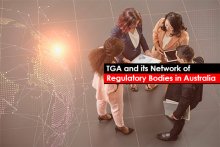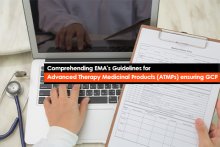Gear up to be Compliant
The future of Pharma Regulations has never been so complex and challenging and at the same time has never been so easy-to-deal with provided the burgeoning section of Regulatory Intelligence service providers feeding the industry with continuous health authority updates and requirements. Setting forth clear cut guidelines to be compliant all across, various health authorities (HAs) worldwide released many guidelines for the manufacturers and pharma companies. Right from mandatory requirement for eCTD submissions, manufacturers might have to cope up with many HA obligations related to submissions, labelling, registrations, renewals etc. in 2017 and Farther. As a critical aspect to roll up to be compliant, we tried to decode them for your convenience. Some of them are:
Publishing and Submissions
US FDA sets DMF eCTD submissions* deadline for May 5, 2017
As directed by the FDA in its eCTD guidance, beginning May 5, 2017, all new DMFs (Drug Master Files), as well as all documents submitted to existing DMFs, must be submitted in an electronic format (eCTD).
The DMF submissions that are not submitted in eCTD format after this assigned date will be thereby rejected. However, the DMF holders whose DMFs are currently in paper form will not be required to resubmit their entire DMF in eCTD format, after May 5, 2017.
FDA eyes mandatory eCTD format for certain submissions types beginning May 5, 2017
In adherence to the FDA directive, beginning May 5, 2017, submission types namely, NDA, ANDA, BLA and Master Files must be submitted in the Electronic Common Technical Document (eCTD) format. The eCTD is CDER/CBER’s standard format for electronic regulatory submissions.
However, for all commercial IND submissions, the deadline is set for May 5, 2018. Submissions that do not comply with the requirements stated in the eCTD Guidance will not be filed or received.
FDA to add technical rejection criteria to existing eCTD validation
Beginning December 17, 2016, be it new drug applications (NDAs), biological license applications (BLAs) or abbreviated new drug applications (ANDAs), the study data that organizations use for compliance must be aligned with the US FDA listed data standards. However, in the case of commercial INDs, FDA says that the requirement starts only after December 17, 2017.
Making it more stringent in terms of enforcing deadlines, the FDA says that technical rejection criterion is being added to the existing electronic Common Technical Document (eCTD) validation criteria. The FDA, on its website, is expected to give 30 days’ notice to the industry prior to the technical rejection criteria becoming effective.
Health Canada to impose eCTD format as mandatory from January 1st 2018 for certain submission types
Health Canada has been accepting regulatory submissions in eCTD format since 2004 but striving towards a common submission intake process, as well as intending to stay aligned with other regulatory authorities, Health Canada is revising the existing requirements.
As per a recent announcement by Health Canada, January 1st 2017 is the date for mandatory filing of all regulatory activities, as per the Common Electronic Submission Gateway (CESG) document. Health Canada also intends to accept all regulatory activity types provided in eCTD format via the CESG in the future.
MCC sets timelines for medicine registration’s eCTD submissions in ZA Module 1 V2.0 till 30 April 2017
The Medicines Control Council (MCC) has given clarity for manufacturers who are willing to submit applications for medicine registrations in electronic common technical document (eCTD) format. The guidance mainly emphasized the implementation timelines of South African Module 1 eCTD Specification and Validation Criteria v2.0.
Starting 1 November 2016, the recent version of South African Module 1 specification for eCTD V2.0 is being implemented. However, MCC has given a grace period of 6 months, from 1 November 2016 to 30 April 2017, for both the versions of South African Module 1 specifications for eCTD.
If by chance the eCTD submissions made after 1 May 2017 do not comply with the South African Module 1 specification for eCTD V2.0, the applications will be rejected. That confirms the final deadline for eCTD submissions in newer format is 1 May 2017.
Post Jan 1st, 2017, SFDA mandates baseline eCTD submissions requirements
The Saudi Food and Drug Authority (SFDA) has updated its Baseline eCTD Submission Requirements, as per which, if an eCTD application is being used for the first time as variation or renewal application, then the applicants are required to submit a technical baseline for the product as this will greatly facilitate the review process. As of 17th July 2016, the Baseline will be optional for products that finished all regulatory activities including initial registration, renewal or variation. But come January 1, 2017, the baseline will be mandatory for any new regulatory activities.
Cosmetics
July 2017 deadline for cosmetic products’ new packaging requirements
With the new cosmetic product license, the CFDA is expected to discontinue all the requirements for displaying QS Labels on the cosmetic products’ packaging, which has been a mandatory requirement to be displayed on all the cosmetics products since 2005. QS stylization is a Chinese quality and safety mark must have to be showcased on all the packages.
From July 1st 2017 onwards, the local cosmetic manufacturers are not required to display QS label and mandated to follow the new packaging requirements. However, the products which are already packaged can be made available in the market till the expiration date after which they need to comply with new packaging requirements.
Labeling
Health Canada releases plain language labeling guidance. For non-prescription products, the Regulations apply as of June 13, 2017
Emphasizing the safety through labeling, Health Canada has released a guidance document for Plain Language Labeling which came into effect from June 13, 2015, for Prescription drugs, and is expected to be in effect from June 13, 2017, for non-prescription drugs.
Well, the motto behind the frequent labeling guidelines is to ensure labels should not only convey accurate drug information to the end user, but should also ensure drug safety by making the information easy to understand by the physician as well as patients.
From 1 September 2020, all medicine labels will need to meet the new TGA rules
Even when the new labelling rules took effect from 31 August 2016 in accordance to the TGA (Therapeutic Goods Administration) Australia, there is a four-year transition period to allow medicine manufacturers time to update their labels and to sell their existing stock. And during this period, both versions are acceptable, i.e., manufacturers need to meet either the old or the new rules.
The labelling requirements for Australian medicines are being updated after several years of consultation with industry, health professionals and the community alike. The primary aim to bring about the changes in Australian medicine labels was to align them with international best practice. Hereon, this will help Australians to make more informed choices about their medicines and use them with care.
General
CDRH’s top 10 Regulatory science priorities for FY 2017
In 2015, the Medical Device’s Regulatory Decision Making Centre for Devices and Radiological Health (CDRH), a division of US Food and Drug Administration (FDA), has published its first set of priorities for 2016. Increasing its outreach for FY 2017, it has been learned that the center was able to identify new topic areas sourced through more needs submissions from internal staff. In the new priority list, the center has discussed the new topic areas (clinical trial design, and precision medicine) as well as described existing topic areas in a detailed fashion. Majorly focused on influencing the Regulatory decision making for medical devices and radiation-emitting products, the CDRH’s comprehensive list of top 10 priorities for FY 2017 includes:
- Leveraging “Big Data” for Regulatory decision-making
- Modernization of biocompatibility and biological risk evaluation of device materials
- Leveraging real-world evidence and employing evidence synthesis across multiple domains in regulatory decision-making
- Enabling advanced tests and methodologies for medical device clinical performance prediction and monitoring
- Developing methods and tools for improving and streamlining clinical trial design
- Developing computational modeling technologies for supporting regulatory decision making
- Enhancing digital health performance and strengthening medical device cybersecurity
- Reducing healthcare-associated infections with better understanding on the effectiveness of antimicrobials, sterilization and reprocessing of medical devices
- Collecting and using patient input in regulatory decision-making
- Leveraging precision medicine and biomarkers for prediction of medical device performance, disease diagnosis and progression
As years pass on, though the Pharma industry is being guided to be part of electronic Regulatory procedures, pharma manufacturers are finding it challenging to cope with hidden complexities and challenges for end-to-end compliance. In such scenarios, apart from being audit-ready right from the first step of drug innovations, they should prefer to opt for a region-specific Regulatory expert to bring their products to market as per the HA requirements. Freyr’s expert Regulatory team has so far assisted some of the global Bio-Pharma (Innovators / Generics), Consumer Healthcare and Medical Device companies. Know more on www.freyrsolutions.com
Reference Links:
http://www.fda.gov/downloads/MedicalDevices/ScienceandResearch/UCM521503.pdf





